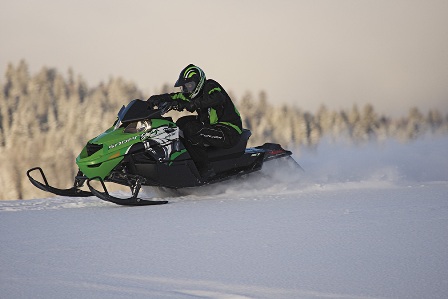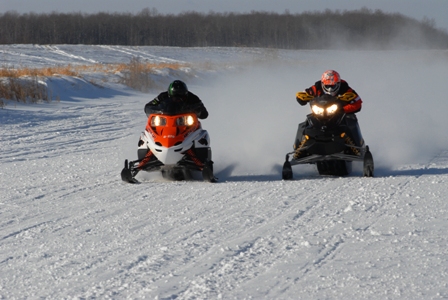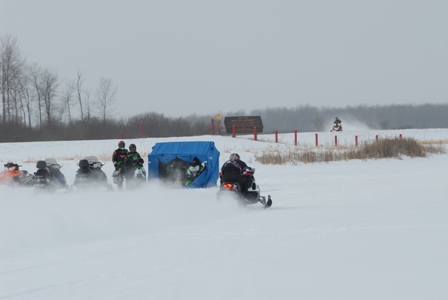
Wishing your sled was a little bit faster? You’re probably giving up free horsepower and top speed. Here’s why I believe that:
In 1994 I had the great fortune of spending a winter cross-country racing under the tutelage of 2-time I-500 champion, Brian Nelson. We had four stock ZR440 race sleds – two for the regular-season cross-country races, one specifically for the I-500 and the other as a practice sled. All four sleds were “built” prior to the season, and we would often compare sleds during testing.
It always amazed how seemingly small set-up changes produced meaningful differences in the top speed of these four buggies. One sled would gain speed if its track was well-broken-in compared to the others, but would lose speed if the hyfax was worn unevenly. Removing inner wheels in the skidframe would add speed in loose snow conditions, but was very susceptible to hyfax burn in hard pack/ice conditions, which of course resulted in speed loss. And how well the hyfax was broken-in/heat treated was a huge influence on top speed.
Despite being built specifically for top speed in the lake/ice cross-country races of the period, the two “regular” race sleds were always the slowest of the bunch. The reason: 192 sharpened ice picks in the track (compared to 96 regular studs in the other two tracks) added significant rotational weight and, presumably, extra resistance at top speeds.
For comfort reasons, the practice sled had a tall windshield. When we swapped it with a short one during one test session, the sled gained 1-2 lengths at top speed.
Ski pressure… trail carbides vs. 10-in. sharpened race bars… track tension… all measurably-influenced top speed which, when comparing side-by-side with an identical sled, never ceased to amaze me.
I share this little piece of personal history because, as has been the case since day one in this sport, the new riding season has produced winners and losers of impromptu drag/speed runs throughout North America. Much of the chatter concerns the Z1 Turbo.
When someone throws down 11k for a new sled whose 177 hp is unmatched in the history of the sport, they don’t want to get beat. I don’t blame them.
But if you’re one of those people, or someone who owns another sled that’s getting beat by its assembly-line mates, never give away free horsepower. The suggestions that Arctic Cat has offered are worth reviewing:
1. Low windshields consistently deliver 2-4 mph higher speeds than mid- or tall-height versions.
2. Use 91 Octane fuel (on models that require/suggest it).
3. Compared to unevenly-worn units, new hyfax add 2-3 mph in most conditions.
4. Drive belt alignment (offset, parallelism and deflection) can play a HUGE role performance loss/gain. Overlook these critical tolerances and you’ll never know what you might be missing.
5. Confirm that specified amount of lube is in the ACT Diamond Drive gearcase. More lube than that will rob speed.
6. Cold temperature and low humidity will produce more hp (and higher speeds); a factor to remember when you’re speedo is registering fewer mph one day than it did the week prior.
7. An over-tensioned track will drop 2-3 mph compared to proper one that’s properly tensioned.
8. The taller the track lug, the better the loose snow acceleration but the slower the top speed. The 1.375-in. Cobra track is an excellent all-around track, but it’s not as fast as the 1-in. Hacksaw on ice or hard pack. The 1.25-in. Ripsaw is best for quick acceleration and good top speed ON FRESH/MEALY SNOW.
Testing at Cat has proven that track type is usually the most significant factor in speed loss/gain.
9. Single-runner wear bars are faster than dual-runners.
As is always the case when it comes to component choice and calibration, a gain in one area (speed) can and often produces a loss in another area (comfort). I hate to compromise, but it’s the way life (and sleds) work.
Optimize the above tips and you will regain the 5-10 mph you may be missing. Afterwards, if you’re still not running even with a similar sled, take note of the biggest trick I learned while racing with Brian Nelson: the line/path you line up on.
The difference between a hard, set-up section of lake and a loose, turned-up section (even if it appears to be hard-packed) is HUGE. As my good friend Pappy used to say, “Always take the path of least resistance.”




If you do not have a sled that is tuned for 91 octane using this fuel will rob you of horsepower also. Just thought I’d add that in. Good article J/S.
Great article! Had the pleasure of meeting Brian Nelson and riding with him on his last tour out at West Yellowstone and then with him again, his first year out at Togwotee. Great guy and the old racing stories were awesome! Man, that guy can ride. I guess, that’s why he was a 2 time I-500 Champion!
John, you should do an article on Brian. Todd
I am the Chief Editor of an adventure magazine interested in running an expanded over-view of this topic with advertising for your company. Please visit us online at http://www.bare-essentials.com.au I look forward to your reply, regards Inga
Hello Inga. If you go to the bottom of any page (including this one), there’s a “contact us” link. Thanks.
2012 f1100 nt i read if i were to 91 octane there would be a hp gain is this true . this would be a stock f1100nt. thanks wait for reply…
That insight’s pfreect for what I need. Thanks!
ADJPdx , [url=http://jszidzxovwmf.com/]jszidzxovwmf[/url], [link=http://rjhdmfwyfobn.com/]rjhdmfwyfobn[/link], http://qtnanyaxiblt.com/
07 f1000 sno pro w/ 2800 miles looses power from 65 up, sled bogs at 3/4 throttle can just get 80 before it feels like it’s going to conk out. Changed the plugs, just fixed secondary (the spacer washer bound up the secondary spring). Throttle cable on clutch side of engine has a wear spot in it but it doesn’t seem to be impeded at all. I haven’t pulled the power valves and cleaned them which is my next step.. Any other suggestions?